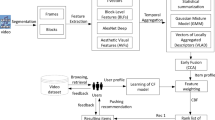Abstract
Auto-tagging movies with apt keywords/tags is essential and indispensable for online video providers. Tagged keywords are beneficial for movie promotion and recommendation. Currently, a popular approach is to propagate tags between similar videos identified by checking image similarity, which in principle takes each video as a sequence of frames. This approach is applicable for short video clips, however it is inefficient in processing long videos such as commercial movies, because it is very rare for two commercial movies to share a large portion of similar frames even if they belong to the same genre. In this work, we propose a novel scheme to auto-tag movies with two major steps. In the first step, we only consider popular movies with tremendous amount of attentions from online users, and we tag them by extracting keywords from user reviews. In the second step, unpopular movies are tagged by propagating the tags of similar popular movies to them. The similarity is evaluated based on multiple quantified attributes, including the movie summary, the title, the country, the genre and the tags, instead of frames to avoid expensive computation cost. To evaluate the performance of our scheme, we conduct experiments using data crawled from Douban, one of the largest movie rating websites in China. Experiment results demonstrate the superiority of our scheme by significantly improving tagging performance (in terms of Precision, Recall and F-Score) in comparison to baseline schemes.








Similar content being viewed by others
Notes
We have removed redundant tags such as tags with the same meaning but in different languages, and meaningless tags such as actor names.
References
Andre B, Vercauteren T, Buchner AM, Wallace MB, Ayache N (2012) Learning semantic and visual similarity for endomicroscopy video retrieval. IEEE Trans Med Imaging 31(6):1276–1288
Ballan L, Bertini M, Uricchio T, Bimbo AD (2015) Data-driven approaches for social image and video tagging. Multimed Tools Appl 74(4):1443–1468
Chen Z, Cao J, Song Y, Guo J, Zhang Y, Li J (2010) Context-oriented web video tag recommendation. Proc Www, pp 1079–1080
Chen M, Zheng A, Weinberger KQ (2013) Fast image tagging. In: International conference on machine learning, pp III–1274
El Aouad S, Dupuy C, Teixeira R, Bach F, Diot C (2016) Exploiting crowd sourced reviews to explain movie recommendation. In: Abdulla PA, Delporte-Gallet C (eds) Networked systems. Springer International Publishing, Cham, pp 193–201
Jeon W, Cho S, Cha J, Byun H (2011) Tag suggestion using visual content and social tag. In: International conference on ubiquitous information management and communication, pp 1–5
Jiang J, Zhang X, Loui AC (2011) A new video similarity measure model based on video time density function and dynamic programming. In: IEEE International conference on acoustics
Le Q, Mikolov T (2014) Distributed representations of sentences and documents. In: International conference on machine learning, pp II–1188
Mihalcea R, Tarau P (2004) Textrank: bringing order into texts. Emnlp, 404–411
Moxley E, Mei T, Hua XS, Ma WY, Manjunath B (2008) Automatic video annotation through search and mining. In: 2008 IEEE international conference on multimedia and expo. IEEE, pp 685–688
Park J, Lee S, Lee SJ, Kim K, Chung BS, Yong KL (2011) Online video recommendation through tag-cloud aggregation. IEEE Multimed 18(1):78–87
Pedro JS, Siersdorfer S, Sanderson M (2011) Content redundancy in youtube and its application to video tagging. Acm Trans Informa Syst 29(3):1–31
Sevil SG, Kucuktunc O, Duygulu P, Can F (2010) Automatic tag expansion using visual similarity for photo sharing websites. Multimed Tools Appl 49(1):81–99
Shan MK, Lee SY (1998) Content-based video retrieval based on similarity of frame sequence
Shen J, Wang M, Chua TS (2016) Accurate online video tagging via probabilistic hybrid modeling. Multimed Syst 22(1):99–113
Siersdorfer S, Pedro JS, Sanderson M (2009) Automatic video tagging using content redundancy. In: International ACM SIGIR conference on research and development in information retrieval, pp 395–402
Tian F, Shen X, Liu X (2018) Multimedia automatic annotation by mining label set correlation. Multimed Tools Appl 77(3):3473–3491
Tran HT, Fromont E, Jacquenet F, Jeudy B, Martins A (2013) Unsupervised video tag correction system. Extraction Et Gestion Des Connaissances Actes, 461–466
Vijayanarasimhan S, Grauman K (2012) Active frame selection for label propagation in videos. In: European conference on computer vision, pp 496–509
Wartena C, Brussee R, Wibbels M (2009) Using tag co-occurrence for recommendation. In: Ninth international conference on intelligent systems design & applications
Wu L, Yang L, Yu N, Hua XS (2009) Learning to tag. In: Proceedings of the 18th international conference on world Wide Web, WWW ’09. ACM, New York, pp 361–370. https://doi.org/10.1145/1526709.1526758
Wu B, Lyu S, Ghanem B (2015) Ml-mg: multi-label learning with missing labels using a mixed graph. In: The IEEE international conference on computer vision (ICCV)
Yi K (2009) A study of evaluating the value of social tags as indexing terms. In: The international conference on knowledge management, pp 221–232
Yu HF, Jain P, Kar P, Dhillon IS (2013) Large-scale multi-label learning with missing labels, 593–601
Zhang ML, Zhou ZH (2007) Ml-knn: a lazy learning approach to multi-label learning. Pattern Recogn 40(7):2038–2048
Zhang X, Huang Z, Shen HT, Yang Y, Li Z (2012) Automatic tagging by exploring tag information capability and correlation. World Wide Web-internet Web Inf Syst 15(3):233–256
Zhao WL, Wu X, Ngo CW (2010) On the annotation of web videos by efficient near-duplicate search. IEEE Trans Multimed 12(5):448–461
Acknowledgments
This work was supported by ARC DE180100950, the National Natural Science Foundation of China under Grant U1911201, Guangdong Special Support Program under Grant 2017TX04X148, the Fundamental Research Funds for the Central Universities under Grant 19LGZD37, 19LGYJS57, 19LGYJS58.
Author information
Authors and Affiliations
Corresponding author
Additional information
Publisher’s note
Springer Nature remains neutral with regard to jurisdictional claims in published maps and institutional affiliations.
Rights and permissions
About this article
Cite this article
Wu, C., Wang, C., Zhou, Y. et al. Exploiting user reviews for automatic movie tagging. Multimed Tools Appl 79, 11399–11419 (2020). https://doi.org/10.1007/s11042-019-08513-0
Received:
Revised:
Accepted:
Published:
Issue Date:
DOI: https://doi.org/10.1007/s11042-019-08513-0




